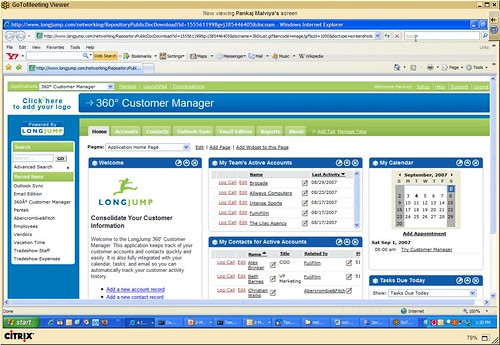Lots of choice in the breakout sessions, but I’ve decided on Rob Koplowitz (who works with Connie Moore) on Web 2.0 and Social Computing in the Enterprise. The official statement:
Enterprise Web 2.0 can drive new efficiencies, but it needs to be approached like any new technology coming into the enterprise.
He had a good slide on how Web 2.0 changes group dynamics, from reviewed repository (predefined contributors and reviewers with a central point of communication) to facilitated community (clusters of communications with a facilitator in each cluster) to social networks (unstructured peer-to-peer communications).
He made a distinction of four types of social networking technologies: “listen to me” (blogs), “listen to us” (wikis), “find people like me” (tagging, profiles, social networks, virtual worlds) and “find stuff I need” (tagging, RSS feeds). He then went on to discuss which of these adds the most value within an enterprise based on research that they’ve done; after instant messaging, which was really just added in as a benchmark, RSS feeds came in as next most useful, which doesn’t really surprise me give what I’ve been seeing in the past months in the Enterprise 2.0 space. What happens, then, is a combined environment of a corporate information workplace with external sources of information, mashed up using various tools to provide value to users.
He referred to RSS as a lightweight integration fabric within organizations, which is a great characterization, and showed it on a spectrum of enablers that also included mashups, SOA and BPM.
Koplowitz then looked at the risks of Web 2.0 technologies within the enterprise, such as privacy and security; note that he’s talking about using consumer Web 2.0 technologies that are available via SaaS on the public internet, whereas there’s a ton of new Enterprise 2.0 solutions that are sold as on-premise, inside-the-firewall solutions rather than risk an improperly-hosted solution. There’s also many reputable Web 2.0 vendors who don’t do risky things with your data, or not any more risky than your own data center does now. He gave a scary-sounding example using Quechup, a recently social networking disaster that decided to spam your entire address book without permission and was quickly outed and shamed on the internet; this information came out with a few short days of this starting, and if the person involved had just been a bit more careful about watching the internet buzz on Quechup rather than jumping right in with their corporate address book exposed, then this would have been a non-story.
His recommendation is not to stop people from using social networking site, but to be cautious and appropriate about what they put out there, and to audit their behavior to ensure that they’re not violating corporate confidentiality. As he points out, Gen Y’s (18-26 years old) are the target hiring market for many companies these days, and they’re using these tools as creators of content as well as participants. However, the higher-level management in most companies, smack in the middle of the boomer years, are much less likely to participate and hence less likely to fund any related efforts.
Forrester will be publishing some research very shortly about vendors in the Enterprise Web 2.0 space, although he didn’t give us much of a sneak preview except to name a few vendors both in the Web 2.0 space and the enterprise space (BEA, Microsoft, SAP, IBM, Oracle), and predicting a collision. Traditional vendors are following the old-style release and adoption cycles, which may not play very well with the faster iterations that will come from the SaaS offerings from the Web 2.0 space; however, those traditional vendors are also in the position to just start bundling their Enterprise 2.0 offerings into their standard offerings (WebSphere Portal as a mashup platform, anyone?) to encourage adoption with their existing customers. There’s a new breed of vendors, however, that have deep enterprise roots and the agility of the hair-on-fire Web 2.0 vendors, that are likely to give the big guys a run for their money. Most likely, any organization is going to use a combination of vendors, both traditional enterprise vendors (who will be favored in the long run, based on history) and the new vendors (who are likely to be acquired by the big vendors). You’ll also see a combination of technologies, for example, ad hoc processes in a wiki with more structured processes in a BPM system linked to that.
His summary:
- Enterprise Web 2.0 is part of the Information Workplace fabric
- Corporations are getting value today from Enterprise Web 2.0
- Users are getting social without appropriate guidance
- Process and content need to be managed
- The investment decision includes change management.
- The vendors are colliding in this space.
There was an interesting discussion during the Q&A on the place of Google in the environment (Koplowitz thinks they have to solve their security issues first, such as not transmitting data to and from Google spreadsheets in clear text).
He points out that for many organizations that have a significant portion of younger workers, especially in technology-heavy industries, there is no way to put this genie back in the bottle; organizations have to deal with this, and “just say no” isn’t an alternative.

